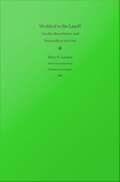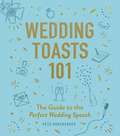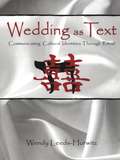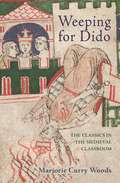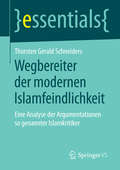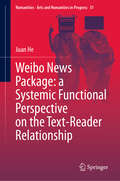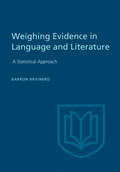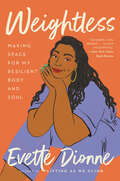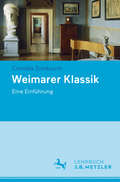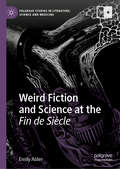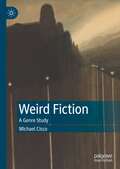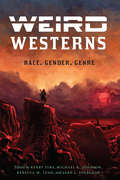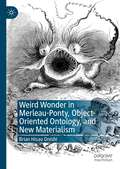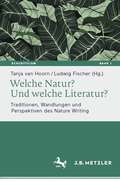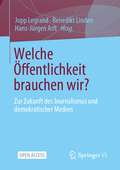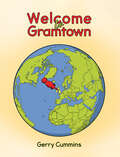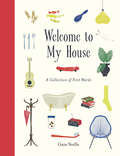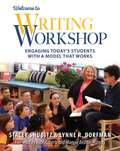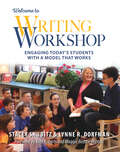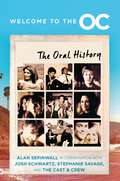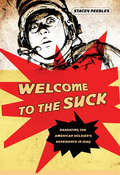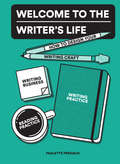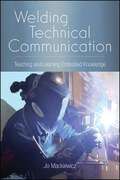- Table View
- List View
Wedded to the Land?: Gender, Boundaries, and Nationalism in Crisis
by Mary N. LayounIn Wedded to the Land? Mary N. Layoun offers a critical commentary on the idea of nationalism in general and on specific attempts to formulate alternatives to the concept in particular. Narratives surrounding three geographically and temporally different national crises form the center of her study: Greek refugees' displacement from Asia Minor into Greece in 1922, the 1974 right-wing Cypriot coup and subsequent Turkish invasion of Cyprus, and the Palestinian and PLO expulsion from Beirut following the Israeli invasion in 1982. Drawing on readings of literature and of official documents and decrees, songs, poetry, cinema, public monuments, journalism, and conversations with exiles, refugees, and public officials, Layoun uses each historical incident as a means of highlighting a recurring trope within constructs of nationalism. The displacement of the Greek refugees in the 1920s calls into question the very idea of home, as well as the desire for ethnic homogeneity within nations. She reads the Cypriot coup and invasion as an illustration of the gendering of nation and how the notion of the inviolable woman came to represent sovereignity. In her third example she shows how the Palestinian and PLO expulsion from Beirut highlights the ambiguity of the borders upon which many manifestations of nationalism putatively depend. These chapters are preceded and introduced by a discussion of "culturing the nation" and closed by a consideration of citizenship and silence in which Layoun discusses rights ostensibly possessed by all members of a political community. This book will be of interest to scholars engaged in cultural and critical theory, Middle Eastern and Mediterranean history, literary studies, political science, postcolonial studies, and gender studies.
Wedding Toasts 101: The Guide to the Perfect Wedding Speech
by Pete HonsbergerWrite and present a memorable wedding toast with this light-hearted, humorous guide that gives you all the tools you&’ll need for a successful speech—the perfect gift for any best man or maid of honor. As much as it&’s an honor to be chosen as the best man or maid of honor at a wedding, giving the perfect speech can sometimes be nerve-wracking. Delivering a crowd-pleasing toast at the reception that has the right amount of humor and sentimentality is a daunting undertaking, no matter how advanced your public speaking skills are. Pete Honsberger&’s guide to giving the perfect wedding toast provides even the most nervous of public speakers with all the tools and advice they need for writing and presenting the best toast ever. After witnessing speeches both good and bad, Honsberger shares a few bits of wisdom he&’s learned along the way, providing building blocks to creating an unforgettable story along with helpful speech prompts, and the perfect checklist that will turn a potentially scary obligation into a golden opportunity. Wedding Toasts 101 presents a fun and simple way to write a successful wedding toast without all the stress so you can spend less time worrying and more time celebrating the happy couple.
Wedding as Text: Communicating Cultural Identities Through Ritual (Routledge Communication Series)
by Wendy Leeds-HurwitzA wedding serves as the beginning marker of a marriage; if a couple is to manage cultural differences throughout their relationship, they must first pass the hurdle of designing a wedding ceremony that accommodates those differences. In this volume, author Wendy Leeds-Hurwitz documents the weddings of 112 couples from across the United States, studied over a 10-year period. She focuses on intercultural weddings--interracial, interethnic, interfaith, international, and interclass--looking at how real people are coping with cultural differences in their lives. Through detailed case studies, the book explores how couples display different identities simultaneously. The concepts of community, ritual, identity, and meaning are given extensive consideration. Because material culture plays a particularly important role in weddings as in other examples of ritual, food, clothing, and objects are given special attention here. Focusing on how couples design a wedding ritual to simultaneously meet multiple--and different--requirements, this book provides: *extensive details of actual behavior by couples; *an innovative format: six traditional theoretical chapters, with examples integrated into the discussion, are matched to six "interludes" providing detailed descriptions of the most successful examples of resolving intercultural differences; *a methodological appendix detailing what was done and why these decisions were made; and *a theoretical appendix outlining the study's assumptions in detail. Wedding as Text: Communicating Cultural Identities Through Ritual is a distinctive study of those who have accepted cultural difference into their daily lives and how they have managed to do so successfully. As such, it is suitable for students and scholars in semiotics, intercultural communication, ritual, material culture, family communication, and family studies, and will be valuable reading for anyone facing the issue of cultural difference.
Weeping for Dido: The Classics in the Medieval Classroom (E. H. Gombrich Lecture Ser. #1)
by Marjorie Curry WoodsSaint Augustine famously “wept for Dido, who killed herself by the sword,” and many later medieval schoolboys were taught to respond in similarly emotional ways to the pain of female characters in Virgil’s Aeneid and other classical texts. In Weeping for Dido, Marjorie Curry Woods takes readers into the medieval classroom, where boys identified with Dido, where teachers turned an unfinished classical poem into a bildungsroman about young Achilles, and where students not only studied but performed classical works.Woods opens the classroom door by examining teachers’ notes and marginal commentary in manuscripts of the Aeneid and two short verse narratives: the Achilleid of Statius and the Ilias latina, a Latin epitome of Homer’s Iliad. She focuses on interlinear glosses—individual words and short phrases written above lines of text that elucidate grammar, syntax, and vocabulary, but that also indicate how students engaged with the feelings and motivations of characters. Interlinear and marginal glosses, which were the foundation of the medieval classroom study of classical literature, reveal that in learning the Aeneid, boys studied and empathized with the feelings of female characters; that the unfinished Achilleid was restructured into a complete narrative showing young Achilles mirroring his mentors, including his mother, Thetis; and that the Ilias latina offered boys a condensed version of the Iliad focusing on the deaths of young men. Manuscript evidence even indicates how specific passages could be performed.The result is a groundbreaking study that provides a surprising new picture of medieval education and writes a new chapter in the reception history of classical literature.
Wegbereiter der modernen Islamfeindlichkeit: Eine Analyse der Argumentationen so genannter Islamkritiker (essentials)
by Thorsten Gerald SchneidersVorgetäuschte Islamkritik, die nur so tut, als verfolge sie seriöse Absichten, ist einer der Hauptverbreitungswege für Islamfeindlichkeit und Vorbehalte gegenüber Muslimen. Im deutschsprachigen Raum hat sich vor einigen Jahren ein Zirkel von Personen gebildet, der diese Art der ,,Islamkritik" öffentlichkeitswirksam vertrat. Dazu gehörten Mina Ahadi, Henryk Broder, Ralph Giordano, Necla Kelek, Alice Schwarzer, Udo Ulfkotte und Leon de Winter. Ihre Argumentationsweisen werden in diesem Essential mittels diskursanalytischer Ansätze untersucht. Der Autor stellt typische Techniken vor und leistet dadurch einen Beitrag, um echte Islamkritik künftig besser von Islamfeindlichkeit abgrenzen zu können.
Weibo News Package: a Systemic Functional Perspective on the Text-Reader Relationship (Numanities - Arts and Humanities in Progress #31)
by Juan HeThis book offers an academic dialogue between news values construction and readers' evaluative response in Weibo news package from the interpersonal perspective. The study focuses on the under-researched field of news reception, i.e. how the media-reader relationship can be influenced by readers' feedback. By combing multimodal discourse analysis and corpus methods, this book aims to address the following three research questions regarding the text-reader relationship in Weibo news package: (1) what are the gains and losses in the transfer of news values constructed across platforms and news media? (2) how are Chinese language and emoji collaborated to realize attitudinal meanings and advance readers' positions in news comments? (3) how does readers' response overlap or mismatch with particular news value in a story across news text-reader relations, reader-reader relations and extra text-reader relations? The book has social, theoretical and pedagogical implications for the changing landscape of (Chinese) news discourse and audience studies. Socially, the findings of news and comments analysis show that news value decisions can be negotiated due to readers' active engagement via the social media commenting function. Theoretically, a responsive model of evaluative readings has been built for a better understanding of social media multimodal comments through the lens of reading positions and emoji-text interactions. The book is of interest to researchers in media and communication studies, but can also be used as a reference book for (under)graduate students in social semiotics, linguistics and journalism to learn how to analyze multimodal and interactive (news) texts on social media by triangulation of theories and methodologies.
Weighting Evidence in Language and Literature
by Barron BrainerdIn recent years, there has been a tremendous development in the area of quantitative and statistical analysis of linguistic and literary data, generated, no doubt, by extensive advances in computer technology and their relatively easy availability to scholars. However, except for a few rather specialized examples, there has been no truly introductory text in statistics and quantitative analysis devoted to the needs of language scholars. This work was written especially to fill the gap. It introduces a mathematically naïve reader to those statistical tools which are applicable in modern quantitative text and language analysis, and does this in terms of simple examples dealing exclusively with language and literature. Exercises are included throughout.
Weightless: Making Space for My Resilient Body and Soul
by Evette DionneA poignant and ruthlessly honest journey through cultural expectations of size, race, and gender—and toward a brighter future—from National Book Award nominee Evette DionneMy body has not betrayed me; it has continued rebounding against all odds. It is a body that others map their expectations on, but it has never let me down.In this insightful, funny, and whip-smart book, acclaimed writer Evette Dionne explores the minefields fat Black woman are forced to navigate in the course of everyday life. From her early experiences of harassment to adolescent self-discovery in internet chatrooms to diagnosis with heart failure at age twenty-nine, Dionne tracks her relationships with friendship, sex, motherhood, agoraphobia, health, pop culture, and self-image.Along the way, she lifts back the curtain to reveal the subtle, insidious forms of surveillance and control levied at fat women: At the doctor’s office, where any health ailment is treated with a directive to lose weight. On dating sites, where larger bodies are rejected or fetishized. On TV, where fat characters are asexual comedic relief. But Dionne’s unflinching account of our deeply held prejudices is matched by her fierce belief in the power of self-love.An unmissable portrait of a woman on a journey toward understanding our society and herself, Weightless holds up a mirror to the world we live in and asks us to imagine the future we deserve.
Weimarer Klassik: Eine Einführung
by Cornelia ZumbuschDie Weimarer Klassik ist eine zentrale, wenn auch umstrittene Epoche der Literaturgeschichte. Diese Einführung skizziert die Diskussion über eine um Goethe und Schiller gruppierte ›Weimarer Klassik‹ und beschreibt ihre Voraussetzungen, Kontexte und Programmatik. Drei umfangreiche Kapitel stellen exemplarische literarische Werke Schillers und Goethes vor, geordnet nach Lyrik, Dramatik und Erzählformen.
Weird Fiction and Science at the Fin de Siècle (Palgrave Studies in Literature, Science and Medicine)
by Emily AlderThis book explores how nineteenth-century science stimulated the emergence of weird tales at the fin de siècle, and examines weird fiction by British writers who preceded and influenced H. P. Lovecraft, the most famous author of weird fiction. From laboratory experiments, thermodynamics, and Darwinian evolutionary theory to psychology, Theosophy, and the ‘new’ physics of atoms and forces, science illuminated supernatural realms with rational theories and practices. Changing scientific philosophies and questioning of traditional positivism produced new ways of knowing the world—fertile borderlands for fictional as well as real-world scientists to explore. Reading Robert Louis Stevenson’s Strange Case of Dr Jekyll and Mr Hyde (1886) as an inaugural weird tale, the author goes on to analyse stories by Arthur Machen, Edith Nesbit, H. G. Wells, William Hope Hodgson, E. and H. Heron, and Algernon Blackwood to show how this radical fantasy mode can be scientific, and how sciences themselves were often already weird.
Weird Fiction: A Genre Study
by Michael CiscoWeird Fiction: A Genre Study presents a comprehensive, contemporary analysis of the genre of weird fiction by identifying the concepts that influence and produce it. Focusing on the sources of narrative content—how the content is produced and what makes something weird—Michael Cisco engages with theories from Deleuze and Guattari to explain how genres work and to understand the relationship between identity and the ordinary. Cisco also uses these theories to examine the supernatural not merely as a horde of tropes, but as a recognition of the infinity of experience in defiance of limiting norms. The book also traces the sociopolitical implications of weird fiction, studying the differentiation of major and minor literatures. Through an articulated theoretical model and close textual analysis, readers will learn not only what weird fiction is, but how and why it is produced.
Weird Westerns: Race, Gender, Genre (Postwestern Horizons)
by Kerry Fine Michael K Johnson Rebecca M Lush Sara L SpurgeonWeird Westerns is an exploration of the hybrid western genre—an increasingly popular and visible form that mixes western themes, iconography, settings, and conventions with elements drawn from other genres, such as science fiction, horror, and fantasy. Despite frequent declarations of the western&’s death, the genre is now defined in part by its zombie-like ability to survive in American popular culture in weird, reanimated, and reassembled forms. The essays in Weird Westerns analyze a wide range of texts, including those by Native American authors Stephen Graham Jones (Blackfeet) and William Sanders (Cherokee); the cult television series Firefly and The Walking Dead; the mainstream feature films Suicide Squad and Django Unchained; the avant-garde and bizarre fiction of Joe R. Lansdale; the tabletop roleplaying game Deadlands: The Weird West; and the comic book series Wynonna Earp. The essays explore how these weird westerns challenge conventional representations by destabilizing or subverting the centrality of the heterosexual, white, male hero but also often surprisingly reinforce existing paradigms in their inability to imagine an existence outside of colonial frameworks.
Weird Wonder in Merleau-Ponty, Object-Oriented Ontology, and New Materialism
by Brian Hisao OnishiThis book connects recent developments in speculative realism, new materialism, and eco-phenomenology to articulate an approach to wonder that escapes the connected traps of anthropocentrism and correlationism. Brian Onishi argues that wonder has explanatory power for the constitution of the world and the organization of meaning. To do this, he appeals to both fiction (speculative and Weird fiction in particular) and quantum physics. More specifically, he argues that the focus of Weird fiction on impossible experiences and a feeling of something just beyond the limits of one’s grasp dramatizes the speculative reach beyond the limits of our understanding. But more than a tool for knowledge acquisition, wonder is an organizing property of objects. Like the collapse of superposition in quantum physics, reality is constituted when objects reveal themselves to other objects and thereby organize themselves into complex objects. Since no relation is exhaustive, the capacity to wonder remains at a material level, and the possibility of reorganization is ever present. Ultimately, Onishi argues for a speculative eco-phenomenology with wonder as an engine for a Weird environmental ethics.
Welche Natur? Und welche Literatur?: Traditionen, Wandlungen und Perspektiven des Nature Writing (Ecocriticism. Literatur-, kultur- und medienwissenschaftliche Perspektiven #1)
by Ludwig Fischer Tanja Van HoornMit diesem Band gewinnt die deutschsprachige Forschung transdisziplinär Anschluss an die internationalen Nature Writing-Diskussionen. Der Sammelband sondiert das Feld des Nature Writing hinsichtlich der Frage, welche Natur dabei in den unterschiedlichen historisch-kulturellen Konstellationen in jeweils welcher spezifischen literarischen Textur zur Darstellung kommt. Programmatisch-konzeptionell stehen damit nicht zuletzt die (möglicherweise verdeckt normativen) Naturvorstellungen des klassischen und rezenten Nature Writing zur Diskussion. Dies wird in exemplarischen Lektüren untersucht, etwa, indem die Kategorien einer ›unberührten‹ Natur bzw. des ›Wilden‹ – auch im Kontext des sogenannten Rewilding – problematisiert oder aber die ästhetisch geformte Darstellung zivilisatorisch veränderter, sei es anthropogen zerstörter, sei es gärtnerischer gestalteter Natur analysiert wird. Präsentiert werden Beiträge aus amerikanistischer, germanistischer, philosophischer und biologiegeschichtlicher Perspektive zu prominenten Vertreter*innen des englischsprachigen Nature Writing (Henry David Thoreau, Val Plumwood u.a.) ebenso wie zu indigenem Natur-Wissen (Robin Wall Kimmerer) und zu Werken deutschsprachiger naturaffiner Autor*innen der Tradition (Adalbert von Chamisso) und Gegenwart (z.B. Ulrike Draesner, Esther Kinsky und W.G. Sebald). Die Untersuchungen ästhetischer Natur-Darstellungsverfahren erfolgen in close readings sowie im Horizont von politischer Ökologie, New Materialism, Ecocriticism, den seit geraumer Zeit gerade in England geführten Diskussionen zu Möglichkeiten und Grenzen eines New Nature Writing und den jüngsten Bestrebungen, die verschüttete Linie eines deutschsprachigen Nature Writing zu rekonstruieren.
Welche Öffentlichkeit brauchen wir?: Zur Zukunft des Journalismus und demokratischer Medien
by Hans-Jürgen Arlt Jupp Legrand Benedikt LindenIn diesem Open Access-Sammelband reflektieren namhafte Autor:innen aus Wissenschaft und Praxis Blockaden und Chancen eines zukünftigen, besseren Mediensystems. Ausgehend von der These, dass Journalismus, Medien und Öffentlichkeit gegenwärtig einen tiefgreifenden strukturellen Wandel durchlaufen, bündelt der Band Kritiken am Status Quo, alternative Wege der Transformation und Vorschläge für Verbesserungen unter dem Stichwort Demokratisierung. Finanzierung, Produktion, Distribution und Rezeption sowie Themensetzung und Formate von Öffentlichkeit werden vor dem Hintergrund langfristiger technologischer, ökonomischer und sozialer Prozesse kritisch analysiert und auf ihr demokratisches Potential abgeklopft.Das Buch richtet sich gleichermaßen an Medien- und Kommunikationswissenschaftler:innen wie an Akteure aus der medienpolitischen und journalistischen Praxis, die im und über das Alltagsgeschäft hinaus den Medienwandel mitgestalten und sich vom Ziel einer demokratischen Öffentlichkeit leiten lassen.
Welcome to Gramtown
by Gerry CumminsPlanet Earth revolves quietly within space, while we Earthlings never notice. In Gramtown, the Noun family are so inactive that nothing ever changes. Watch out! The Nouns are about to have their world shaken up by new neighbours: the Verbs; one little nudge over the garden fence and life will never be the same again. What tales will be created in Gramtown? Get ready to dive in – but watch out – it might get messy, especially with Digger and Sleaky!
Welcome to My House: A Collection of First Words
by Gaia StellaFirst words are everywhere you look, especially in a house! This visually striking picture book catalogs an impressive array of household items, naming the delightful miscellany that comprises a life. The charming collections are creative and unexpected, providing the sweetest of visual snapshots that reinforce word recognition and understanding. In addition to the everyday kitchen, living room, and garden items, there are surprising and smart illustrated spreads featuring "everything for resting," "everything for warming up," and "everything that gets lost." Plus, a seek-and-find element (a hiding cat!) offers bonus amusement. Children will savor the delicate illustrations of things they are learning to recognize, things they are discovering every day, and things they will cherish and use as they grow.
Welcome to My House: A Collection of First Words
by Gaia StellaFirst words are everywhere you look, especially in a house! This visually striking picture book catalogs an impressive array of household items, naming the delightful miscellany that comprises a life. The charming collections are creative and unexpected, providing the sweetest of visual snapshots that reinforce word recognition and understanding. In addition to the everyday kitchen, living room, and garden items, there are surprising and smart illustrated spreads featuring "everything for resting," "everything for warming up," and "everything that gets lost." Plus, a seek-and-find element (a hiding cat!) offers bonus amusement. Children will savor the delicate illustrations of things they are learning to recognize, things they are discovering every day, and things they will cherish and use as they grow.
Welcome to My House: A Collection of First Words
by Gaia StellaFirst words are everywhere you look, especially in a house! This visually striking picture book catalogs an impressive array of household items, naming the delightful miscellany that comprises a life. The charming collections are creative and unexpected, providing the sweetest of visual snapshots that reinforce word recognition and understanding. In addition to the everyday kitchen, living room, and garden items, there are surprising and smart illustrated spreads featuring "everything for resting," "everything for warming up," and "everything that gets lost." Plus, a seek-and-find element (a hiding cat!) offers bonus amusement. Children will savor the delicate illustrations of things they are learning to recognize, things they are discovering every day, and things they will cherish and use as they grow.
Welcome to Writing Workshop: Engaging Today's Students with a Model That Works
by Stacey Shubitz Lynne DorfmanWelcome to Writing Workshop will help both novice and veteran teachers implement their own workshops in their own classrooms with more confidence. Reading specialists and support teachers can benefit from the experiences and descriptions of key components of writing workshop since they often support struggling readers and writers in small-group situations. This book is for administrators, too, who will observe writing workshops and offer praise and polish. The authors have used their combined years of classroom experience as writing teachers and literacy coaches to share real classroom experiences and validate their suggestions and conclusions. This book will be useful for professional learning communities and teacher-initiated partnerships and book clubs to grow in confidence and knowledge of how a teacher of writers builds and maintains a community of writers in writing workshop.
Welcome to Writing Workshop: Engaging Today's Students with a Model That Works
by Stacey Shubitz Lynne DorfmanStacey Shubitz and Lynne Dorfman welcome you to experience the writing workshop for the first time or in a new light with Welcome to Writing Workshop: Engaging Today's Students with a Model That Works . Through strategic routines, tips, resources, and short focused video clips, teachers can create the sights and sounds of a thriving writing workshop where:• Both students and teachers are working authors• Students spend most of their time writing—not just learning about it• Student choice is encouraged to help create engaged writers, not compliant ones• Students are part of the formative assessment process• Students will look forward to writing time—not dread it.From explanations of writing process and writing traits to small-group strategy lessons and mini-lessons, this book will provide the know-how to feel confident and comfortable in the teaching of writers.
Welcome to the O.C.: The Oral History
by Alan Sepinwall Josh Schwartz Stephanie Savage“A fascinating peek behind the making of a megahit, and a delightful bit of nostalgia for those of us who remember life before streaming TV.” —Town & CountryWelcome to the O.C., b*tch: it’s the definitive oral history of beloved TV show The O.C., from the show’s creators, featuring interviews with the cast and crew, providing a behind-the-scenes look into how the show was made, the ups and downs over its four seasons, and its legacy today. On August 5th, 2003, Ryan Atwood found himself a long way from his home in Chino—he was in The O.C., an exclusive suburb full of beautiful girls, wealthy bullies, corrupt real-estate tycoons, and a new family helmed by his public defender, Sandy Cohen. Ryan soon warms up to his nerdy, indie band-loving new best friend Seth, and quickly falls for Marissa, the stunning girl next door who has secrets of her own. Completing the group is Summer, Seth’s dream girl and Marissa’s loyal—and fearless—best friend. Together, the friends fall in and out of love, support each other amidst family strife, and capture the hearts of audiences across the country.Just in time for the show’s twentieth anniversary, The O.C.’s creator Josh Schwartz and executive producer Stephanie Savage are ready to dive into how the show was made, the ups and downs over its four seasons, and its legacy today. With Rolling Stone’s chief TV critic and bestselling author Alan Sepinwall conducting interviews with the key cast members, writers, and producers who were there when it all happened, Welcome to the O.C. will offer the definitive inside look at the beloved show—a nostalgic delight for audiences who watched when it aired, and a rich companion to viewers currently discovering the show while it streams on HBO Max and Hulu.The O.C. paved the way for a new generation of iconic teen soaps, launched the careers of young stars, and even gave us the gift of Chrismukkah. Now, it’s time to go back where we started from and experience it all over again. Includes exclusive interviews with: Ben McKenzie * Mischa Barton * Adam Brody * Rachel Bilson * Peter Gallagher * Kelly Rowan * Melinda Clarke * Tate Donovan * Chris Carmack * Autumn Reeser * Willa Holland * Samaire Armstrong * Alan Dale * Colin Hanks * Amanda Righetti * Navi Rawat * Shannon Lucio * Michael Cassidy * McG * Imogen Heap * Alex Greenwald * Ben Gibbard * Paul Scheer * Doug Liman * and many more!
Welcome to the Suck: Narrating the American Soldier's Experience in Iraq
by Stacey PeeblesOur collective memories of World War II and Vietnam have been shaped as much by memoirs, novels, and films as they have been by history books. In Welcome to the Suck, Stacey Peebles examines the growing body of contemporary war stories in prose, poetry, and film that speak to the American soldier’s experience in the Persian Gulf War and the Iraq War. Stories about war always encompass ideas about initiation, masculinity, cross-cultural encounters, and trauma. Peebles shows us how these timeless themes find new expression among a generation of soldiers who have grown up in a time when it has been more acceptable than ever before to challenge cultural and societal norms, and who now have unprecedented and immediate access to the world away from the battlefield through new media and technology.Two Gulf War memoirs by Anthony Swofford (Jarhead) and Joel Turnipseed (Baghdad Express) provide a portrait of soldiers living and fighting on the cusp of the major political and technological changes that would begin in earnest just a few years later. The Iraq War, a much longer conflict, has given rise to more and various representations. Peebles covers a blog by Colby Buzzell ("My War"), memoirs by Nathaniel Fick (One Bullet Away) and Kayla Williams (Love My Rifle More Than You); a collection of stories by John Crawford (The Last True Story I’ll Ever Tell); poetry by Brian Turner (Here, Bullet); the documentary Alive Day Memories; and the feature films In the Valley of Elah and the winner of the 2010 Oscar for Best Picture, The Hurt Locker, both written by the war correspondent Mark Boal. Books and other media emerging from the conflicts in the Gulf have yet to receive the kind of serious attention that Vietnam War texts received during the 1980s and 1990s. With its thoughtful and timely analysis, Welcome to the Suck will provoke much discussion among those who wish to understand today’s war literature and films and their place in the tradition of war representation more generally.
Welcome to the Writer's Life: How to Design Your Writing Craft, Writing Business, Writing Practice, and Reading Practice
by Paulette PerhachAlways wanted to be a writer? Stop wasting time and start your writing life today! With warmth and humor, the author welcomes you into the writer’s life as someone who has been there on the other side looking in. Like a freshman orientation for writers, this book includes an in-depth exploration of all the elements of a writer's life, from your writing practice to your reading practice, to your writing craft and the all-important and often-overlooked business of writing. Harness the powers of crowdsourcing and social media to grow your writing career, and use the most current research on success, gamification, and lifestyle design to take your writing life to the next level. Complete with writing exercises, tools, checklists, infographics, and behind-the-scenes tips from working writers of all types, this book offers everything you need to jump-start a successful writing life.
Welding Technical Communication: Teaching and Learning Embodied Knowledge (SUNY series, Studies in Technical Communication)
by Jo MackiewiczWelding Technical Communication explores the teaching and learning of welding through two narratives. The personal narrative relates the author’s experience as a woman learning how to weld. The academic narrative draws upon scaffolded learning theory to examine how four welding teachers’ verbal and nonverbal communication—their tutoring strategies and their gestures—facilitated students’ embodied knowledge and enculturation into a community of practice. This book fills a gap in technical communication research: we do not fully understand how teachers’ pedagogical technical communication scaffolds students’ learning within the skilled trades. Novel in its approach and coverage, Welding Technical Communication will interest researchers in technical communication and technical education.
